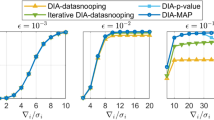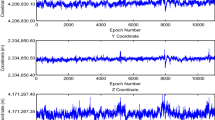Abstract
Based on the unifying framework of the detection, identification and adaption (DIA) estimators, quality control indices are refined and formulated by taking the uncertainty of the combined estimation-testing procedure into account and performing the propagation of uncertainty. These indices are used to measure the confidence levels of the testing decisions, the reliability of the specified alternative hypothesis models, as well as the biasedness and dispersion of the estimated parameters. A simplified algebraic estimation (SAE) method is developed to calculate these quality control indices for the application of single outlier DIA. Compared to the conventional Monte Carlo simulation method, the proposed SAE method can achieve an adequate estimation accuracy and significantly higher computation efficiency. Using a GNSS single-point positioning example, the performance of the SAE method is evaluated and the quality control of the conventionally used DIA estimator is demonstrated for practical applications.







Similar content being viewed by others
Data availability
Necessary data are accessible in the Numerical Example Section of the manuscript.
References
Alberda JE (1976) Quality control in surveying. Chart Surv 4(2):23–28
Baarda W (1967) Statistical concepts in geodesy. Netherlands Geodetic Commission Publication on geodesy, Delft
Baarda W (1968) A testing procedure for use in geodetic networks. Netherlands Geodetic Commission Publication On geodesy, Delft
BaardaW (1976) Reliability and precision of geodetic networks. Tech. rep., VII Int Kurs fur Ingenieursmessungen hoher Prazision, Band I, T.H. Darmstadt, Inst. fur Geodaesie
Chen Y, Wang J (1996) Reliability measure for correlated observations. Z Vermess 121(5):211–219
Förstner W (1983) Reliability and discernability of extended Gauss-Markov models. Seminar on mathematical models to outliers and systematic errors, Series A, No. 98, Deutsche Geodätische Kommision, Munich, Germany, pp. 79–103
Förstner W (1985) The reliability of block triangulation. Photogramm Eng Remote Sens 51(6):1137–1149
Hekimoglu S, Berber M (2003) Effectiveness of robust methods in heterogeneous linear models. J Geod 76(11–12):706–713
Leick A, Emmons MB (1994) Quality control with reliability for large GPS networks. J Surv Eng 120(1):25–41
Lehmann R, Scheffler T (2011) Monte Carlo-based data snooping with application to a geodetic network. J Appl Geod 5:123–134
Lehmann R (2012) Improved critical values for extreme normalized and studentized residuals in Gauss–Markov models. J Geod 86(12):1137–1146
Lehmann R (2013) On the formulation of the alternative hypothesis for geodetic outlier detection. J Geod 87(4):373–386
Lehmann R (2014) Transformation model selection by multiple hypotheses testing. J Geod 88:1117–1130
Lehmann R, Lösler M (2016) Multiple outlier detection: hypothesis tests versus model selection by information criteria. J Surv Eng 142(4):04016017
Lehmann R, Lösler M, Neitzel F (2020) Mean shift versus variance inflation approach for outlier detection: a comparative study. Mathematics 8(6):991
Koch KR (1999) Parameter estimation and hypothesis testing in linear models, 2nd edn. Springer, Berlin
Li B, Shen Y, Lou L (2011) Efficient estimation of variance and covariance components: a case study for GPS stochastic model evaluation. IEEE Trans Geosci Remote Sensing 49(1):203–210
Koch KR (2015) Minimal detectable outliers as measures of reliability. J Geod 89:483–490
Kok JJ (1984) On data snooping and multiple outlier testing. US Department of Commerce, National Oceanic and Atmospheric Administration, National Ocean Service, Charting and Geodetic Services
Ou J (1999) On the reliability for the situation of correlated observations. Acta Geodaetica et Cartographica Sinica, English Edition, pp 9–17
Pelzer H (1980) Some criteria for the reliability of networks. Deutsche Geodätische Kommission, Munchen
Pope AJ (1976) The statistics of residuals and the detection of outliers. NOAA Technical Report NOS 65 NGS 1, U.S. National Geodetic Survey, MD, USA
Ryan S, Lachapelle G (2001) Marine positioning multiple multipath error detection. Hydrogr J 100:3–11
Schaffrin B (1997) Reliability measures for correlated observations. J Surv Eng 123(3):126–137
Teunissen PJG (1985) Quality control in geodetic networks. In: Grafarend EW, Sanso F (eds) Optimization and design of geodetic networks. Springer, Berlin, pp 526–547
Teunissen PJG (2006) Testing theory an introduction. Series on mathematical geodesy and positioning, 2nd edn. Delft University of Technology, Delft
Teunissen PJG (2018) Distributional theory for the DIA method. J Geod 92:59–80
Teunissen PJG, Zaminpardaz S, Tiberius C (2020) On the integrity of deformation monitoring. Geomat Nat Hazards Risk 11(1):399–413
Wang J, Chen Y (1999) Outlier detection and reliability measures for singular adjustment models. Geomat Res Aust 71:57–72
Wieser A (2004) Reliability checking for GNSS baseline and network processing. GPS Solut 8:55–66
Xu P (1987) A test method for many outliers. ITC J 4:314–317
Yang L, Wang J, Knight NL, Shen Y (2013) Outlier separability analysis with a multiple alternative hypotheses test. J Geod 87(6):591–604
Yang L, Li B, Shen Y, Rizos C (2017) An extension of internal reliability analysis regarding to separability analysis. J Surv Eng 143(3):04017002
Yang L, Shen Y, Li B (2019) M-estimation using unbiased median variance estimate. J Geod 93:911–925
Yang L, Shen Y (2020) Robust M estimation for 3D correlated vector observations based on modified bifactor weight reduction model. J Geod 94:31
Zaminpardaz S, Teunissen PJG (2019) DIA-datasnooping and identifiability. J Geod 93:85–101
Zaminpardaz S, Teunissen PJG, Tiberius C (2020) A risk evaluation method for deformation monitoring systems. J Geodesy 94(3):28
Acknowledgements
This work is sponsored by the National Natural Science Foundation of China (41731069, 41504022), the Shanghai Natural Science Foundation (20ZR1462000), and the Open Research Fund Program of LIESMARS (Grant No. 19R02).
Author information
Authors and Affiliations
Contributions
LY proposed the key idea, designed the research, processed data, and wrote the paper draft; YS and BL supervised the research and revised the manuscript; CR substantively revised the manuscript.
Corresponding author
Ethics declarations
Conflict of interest
The authors declare that the have no conflict of interest.
Appendix
Appendix
The detailed proof for Eqs. (37–39) is as follows.
Under hypothesis \({\mathcal{H}}_{i}\), there is.
From Eq. (37), it is derived
It can be simplified as
Similarly, the variance is
Rights and permissions
About this article
Cite this article
Yang, L., Shen, Y., Li, B. et al. Simplified algebraic estimation for the quality control of DIA estimator. J Geod 95, 14 (2021). https://doi.org/10.1007/s00190-020-01454-9
Received:
Accepted:
Published:
DOI: https://doi.org/10.1007/s00190-020-01454-9




